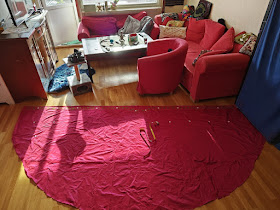In July 2019 I started on an embroidered silk cloak, inspired by a cloak described the 13th century Möttuls saga. Möttuls saga is an Old Norse text which was probably based on the Old French Le Cort Mantel, and was adapted into Old Norse by a cleric known as Brother Robert, probably of Anglo-Norman origin, for King Haakon IV of Norway (1217–1263). I had made a presentation about clothing in a collection of Norwegian translations of courtly romances for Leeds medieval congress in 2019.
You can read more about the inspiration, the sources, etc in a blog post that I made then.
Well, in November 2019 I hit total burnout, in fact I am still not well enough to work more than 25%, and while I have made lots of clothing since 2021, when I finally was able to sew again, the cloak was lying there, packed away in a fabric bag.
My friend Anna kept reminding me of it, whenever I complained that I didn't have any hand sewing for when we hung out watching historical costume movies/series together. But it was The Lazy Reenactor Girl's 30 days of A&S (Arts&Sciences) challenge in September this year that actually made me pick it up again.
I hade made around 90 centimeres on the front border when I put it away, and now I have embroidered another 240 cm. And some flowers.
Since the cloaks is described as being embroidered all over with flowers and leaves, I have quite a lot of embroidery left to do. I'm startinf with the flowers spaced evenly over the whole cloak, and then I will have to figure out the foliage.I am using "gold" thread, with a strip of metal wound around a yellow thread, which I am couching down with yellow silk, green silk embroidery floss, and white sewing silk.




























